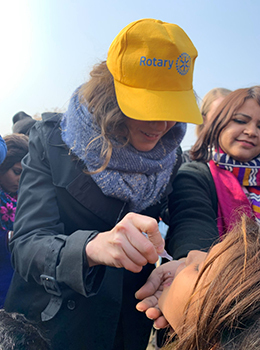
Health workers administer polio vaccine to migrant families during a National Immunization Day organized by UNICEF and its GPEI partners in Ghaziabad, India, in January.
By Stephanie Herzfeld
On 27 March 2020, the World Health Organization’s South-East Asia Region recognizes six years of polio-free certification.
To be sure, this is an important benchmark as we progress toward a polio-free world, but as I look back on my first National Immunization Day trip to India, the country in the region once considered the most difficult to bring to zero cases, this date has now taken on a new personal significance.

Stephanie Herzfeld administers the polio vaccine during the National Immunization Day.
Prior to the January NID trip—in which I accompanied members of the press—I felt I had a solid grasp on Rotary’s polio efforts and its leading role in the Global Polio Eradication Initiative (GPEI). As part of Rotary International’s public relations team, I’ve put together many, many reference documents highlighting key dates, strategies and figures that underscore our members’ commitment to the cause and prove that our collective efforts pay off.
But all of this information fell to the background when we reached Ghaziabad in Uttar Pradesh on 19 January and the polio program—and its tactics—suddenly sprang to life. As we stepped out of our van and walked to the vaccination site where local program workers were organizing a massive group of young children and parents, the process of administering the oral polio vaccine (OPV) and the future impact of that vaccine on these kids suddenly became quite real.
All of us were eager to experience delivering the two drops of vaccine, and when my turn came, adrenaline rushed through me as I approached a little boy—what if I made a mistake and dispensed too little vaccine? Or, too much? Fortunately, it turned out to be simple, and there was no need to worry. That made perfect sense, as I was following in the footsteps of the many Rotary members who had come to India to take part in this very activity. Volunteers are encouraged to administer the OPV, a testament to the fact that you don’t have to be a global health expert to support efforts to end polio.
In the end, the little boy swallowed the drops, closed his mouth, and the line of children progressed. Before I knew it, I was delivering drops to a little girl, the next in line.
As our group wrapped up our work in Ghaziabad, and we made our way back to the van, we tried to process what we had just experienced. The kids rushed to our van, waving and smiling as they saw us off. After it was over, I grasped the importance of each and every person and organization in the global effort to end polio in a new way. Beyond comprehending data points on paper, I acutely felt the global effort, and the tremendous efforts of Rotarians, to eradicate polio and the unwavering determination it took to bring India and the region to a polio-free status.
The experience crystallized the program in a way I hadn’t anticipated possible, and I’m grateful I had the opportunity to learn about it firsthand and play the tiniest of roles in supporting India’s efforts to remain polio-free. Visit endpolio.org to find out how you can help end polio for good.
https://blog.rotary.org/2020/03/27/polio-beyond-the-talking-points/
